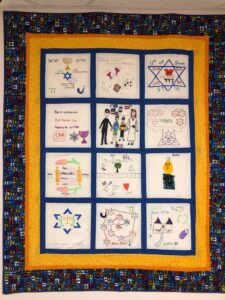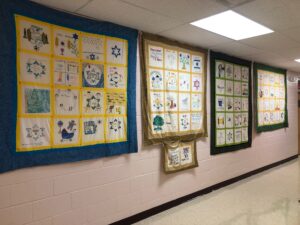Posted on January 15, 2021 by Sarah Gluck
January 2021. Imagine for a moment that you are a visitor from another planet. You’ve somehow arrived in central New Jersey and are standing in, of all places, the Temple Beth-El parking lot, which is empty. There is a structure before you. Although you look around for indications that other beings are present, there are no visible signs of movement. Approaching the structure, you peer through the glass, and somehow find yourself inside. A door beckons you, so you go through it and up the stairs. Hanging in front of you is a large, colorful object with many different patterns and designs. You look more closely and see that it is made up of many small objects that have been pieced together, and that each small object has its own unique design. On each small object there are also series of symbols that go from either side toward the center.
 Passing through another door, you discover many more of these large, colorful objects. You continue to move throughout the structure, until you have seen more than 20, and you begin to understand that these objects are important. What are they? What do they represent? Do they mean something?
Passing through another door, you discover many more of these large, colorful objects. You continue to move throughout the structure, until you have seen more than 20, and you begin to understand that these objects are important. What are they? What do they represent? Do they mean something?
We human beings, inhabitants of Earth, residents of central New Jersey, members of Temple Beth-El, know that these objects are quilts. And many of us know that each of these quilts is the product of a fourth-grade family education program on the Jewish lifecycle. We know each square represents a significant moment in the life of a family and that each quilt as a whole represents a lived Jewish experience. Because so many of us participated in their creation, we understand that these quilts are our living history, and we count them among the most beautiful and precious artifacts in our temple archives.
The quilts, which hang on the walls on both floors of the school wing and in the stairwells, tell many stories. Each square represents a significant Jewish moment in the life of a family; together, they represent the collective experience of a group of families. With these quilts, the milestone events of these family cohorts are memorialized for them and the entire temple community. The walls of the temple building are memory walls.
When these fourth-grade families talked about and designed their squares, they also made connections to one another. After the pieces were stitched together, the children took pleasure in seeing their special piece on the wall. They were — are — proud of their Jewish heritage. When our children grow up and eventually move away, the quilts remain: a tangible and very personal reminder of their connection to the temple and their Jewish identity.
The quilts are colorful and beautifully made. They are aesthetically pleasing. They warm the space, and they warm the hearts of all who see them.
As the work of many hands, the quilts represent the down-to-earth, hands-on personality of the congregation. They tell us Temple Beth-El is a warm, people-oriented place. They tell us ours is a community that values pre-serving and bequeathing Jewish heritage. They tell us ours is a congregation that is proud of and honors its own history.
The grade 4 family ed program was the brainchild of Debra Siroka and Rabbi Gluck almost 25 years ago and continued by Lisa Friedman. The quilts have been lovingly stitched since the beginning by a few congregants who have volunteered their talents and time to transform the individual patches into vibrant living history. Long-time temple members and volunteers extraordinaire Cindy Scott Goldberg and Caren Bateman have been involved from the beginning and have been kind enough to share their remembrances with us.
Cindy Scott Goldberg: I think it started when two of our kids were in fourth grade. It was Caren’s and my first quilt (and the temple’s first quilt), and we’ve done them all for the entire 24 years. They have always been a labor of love for me and Caren. It has been a joy to see those squares for the first time with each class and help piece together that particular class’s individual squares into their own fourth-grade religious school history/story together. Like each class, every quilt is unique. They are all vibrant in their own way. Caren and I try to complement the unique colors in the squares with the fabric we choose for binding and borders.
 (Though I have to say that a few years back, we ventured from the blue family into some more unexpected colors!) Some classes had a lot of students, which meant two quilts for that class. Some classes have been smaller and only needed one quilt. They are all special (like children!), and each tells its own story (as quilts always do). Caren will also tell you the quilter leaves a little bit of themselves in their quilts, so Caren and I are quietly here, too. It’s impossible to choose favorites, but some squares were particularly meaningful because of who or what they represented. I love the last two we did, for the 2018-2019 and 2019-2020 classes. The two 2018-2019 quilts are near where the IHN families stay, and I remember that someone told me one of the young children was staring at them because they were so beautiful. Who knows when and how quilts speak to or touch people?
(Though I have to say that a few years back, we ventured from the blue family into some more unexpected colors!) Some classes had a lot of students, which meant two quilts for that class. Some classes have been smaller and only needed one quilt. They are all special (like children!), and each tells its own story (as quilts always do). Caren will also tell you the quilter leaves a little bit of themselves in their quilts, so Caren and I are quietly here, too. It’s impossible to choose favorites, but some squares were particularly meaningful because of who or what they represented. I love the last two we did, for the 2018-2019 and 2019-2020 classes. The two 2018-2019 quilts are near where the IHN families stay, and I remember that someone told me one of the young children was staring at them because they were so beautiful. Who knows when and how quilts speak to or touch people?
Amy Rubin tells us that she always mentions the quilt project when she does a tour of the school wing with prospective members and says all of her children know where their quilts are.
Caren Bateman: The quilts have been a pleasure to work on through these years. I believe we started in 1995-1996, and the first quilt may be hanging in the stairwell in the middle of the building [opposite the library]. Credit for most of the quilt work goes to Cindy Scott, who chooses and purchases fabric, sews the lattice strips onto the squares, and adds borders on the quilts. I believe she also cuts the squares now, as we had some issues with sizing in the beginning. I have put bindings on some of the quilts, but Cindy does the bulk of the work and does it very well. (I believe Julie Hirsch has also contributed.) Each quilt has its own character, and they become friends as we work on them. Without children in the school, I don’t have as much opportunity to be in the school wing, but I do enjoy visiting my “friends” when I stay overnight with IHN. They are a colorful addition to the walls, and I know that many of our school children search for “their” quilts after they’ve completed their squares.
The quilts are a tangible project where each child expresses a Jewish life cycle event that has meaning for them and their families. Cindy turns their art into a beautiful wall hanging, preserving part of each child’s Jewish identity. I know many people, young and old, have gotten pleasure from these quilts. Many of the children look forward to making their own square — it’s almost like a first lifecycle event for them.
Just before I began my temple presidency, I attended the Scheidt Seminar, a conference for newly elected temple presidents. There is a show-and-tell session (a poster-type event), where each participant is asked to bring something, either a project or an idea, to share with the others. I chose to bring pictures of some of the quilts, and they were very well-received!
The number of families who are represented by the quilts, and the generous, heartfelt contributions made over the years by our dedicated volunteers, are astonishing and deeply moving. When the difficult circumstances of Covid-19 are past and our physical space is once again open and buzzing with activity, remember to stroll through the school wing and marvel at these beautiful pieces of living heritage, not through the eyes of a visiting stranger, but as a member of a community returning home.
L’shalom,
Sarah Gluck
Originally published in the January-February 2021 issue of the Shofar. For more issues of the Shofar, visit the Shofar archives.